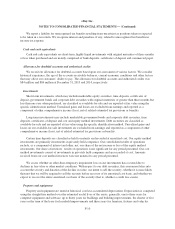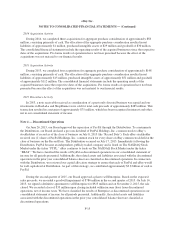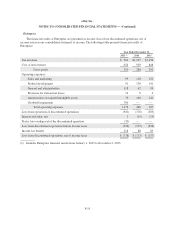eBay 2015 Annual Report Download - page 85
Download and view the complete annual report
Please find page 85 of the 2015 eBay annual report below. You can navigate through the pages in the report by either clicking on the pages listed below, or by using the keyword search tool below to find specific information within the annual report.eBay Inc.
NOTES TO CONSOLIDATED FINANCIAL STATEMENTS — (Continued)
Goodwill and intangible assets
Goodwill is tested for impairment at a minimum on an annual basis. Goodwill is tested for impairment at the
reporting unit level. A qualitative assessment can be performed to determine whether it is more likely than not
that the fair value of the reporting unit is less than its carrying value. If the reporting unit does not pass the
qualitative assessment, then the reporting unit’s carrying value is compared to its fair value. The fair values of the
reporting units are estimated using income and market approaches. Goodwill is considered impaired if the
carrying value of the reporting unit exceeds its fair value. The discounted cash flow method, a form of the
income approach, uses expected future operating results and a market participant discount rate. The market
approach uses comparable company prices and other relevant information generated by market transactions
(either publicly traded entities or merger and acquisitions) to develop pricing metrics to be applied to historical
and expected future operating results of our reporting units. Failure to achieve these expected results, changes in
the discount rate or market pricing metrics may cause a future impairment of goodwill at the reporting unit. We
conducted our annual impairment test of goodwill as of August 31, 2015 and 2014. Additionally, we evaluated
impairment based on the significant activities regarding the Distribution and Enterprise divestiture during the
year. See “Note 4 — Discontinued Operations” for further detail. As a result of this test, we determined that no
further adjustment to the carrying value of goodwill for any reporting units was required.
Intangible assets consist of purchased customer lists and user base, marketing related, developed
technologies and other intangible assets, including patents and contractual agreements. Intangible assets are
amortized over the period of estimated benefit using the straight-line method and estimated useful lives ranging
from one to eight years. No significant residual value is estimated for intangible assets.
Impairment of long-lived assets
We evaluate long-lived assets (including intangible assets) for impairment whenever events or changes in
circumstances indicate that the carrying amount of a long-lived asset may not be recoverable. An asset is
considered impaired if its carrying amount exceeds the undiscounted future net cash flow the asset is expected to
generate. In 2015, 2014 and 2013, no impairment was noted.
Foreign currency
Most of our foreign subsidiaries use the local currency of their respective countries as their functional
currency. Assets and liabilities are translated at exchange rates prevailing at the balance sheet dates. Revenues,
costs and expenses are translated into U.S. dollars using daily exchange rates if the transaction is recorded in our
accounting systems on a daily basis, and otherwise using average exchange rates for the period. Gains and losses
resulting from the translation of our consolidated balance sheet are recorded as a component of accumulated
other comprehensive income.
Gains and losses from foreign currency transactions are recognized as interest and other, net.
Derivative instruments
We use derivative financial instruments, primarily forwards and swaps, to hedge certain foreign currency
and interest rate exposures. We may also use other derivative instruments not designated as hedges, such as
forwards used to hedge foreign currency balance sheet exposures. We do not use derivative financial instruments
for trading purposes. See “Note 9 — Derivative Instruments” for a full description of our derivative instrument
activities and related accounting policies.
F-11
























